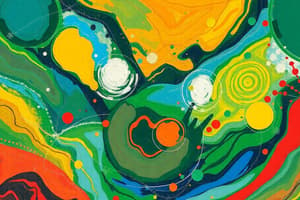Podcast
Questions and Answers
What is the primary objective of the lesson plan focused on material cycles?
What is the primary objective of the lesson plan focused on material cycles?
- Students will be able to explain the importance of material cycles in living organisms and ecosystems. (correct)
- Students will learn to create videos on material cycles.
- Students will memorize various material cycles.
- Students will develop skills for conducting scientific experiments.
Which of the following is NOT mentioned as a material cycle in the lesson plan?
Which of the following is NOT mentioned as a material cycle in the lesson plan?
- Nitrogen cycle
- Carbon cycle
- Water cycle
- Oxygen cycle (correct)
How will students demonstrate their understanding of material cycles?
How will students demonstrate their understanding of material cycles?
- By creating a digital presentation illustrating a material cycle. (correct)
- By completing a multiple-choice quiz on ecosystems.
- By taking a written exam on material cycles.
- By participating in a hands-on experiment.
What aspect of engagement is assessed during peer presentations?
What aspect of engagement is assessed during peer presentations?
Which phase involves students conducting research on their assigned material cycle?
Which phase involves students conducting research on their assigned material cycle?
What role do material cycles play in ecosystems according to the lesson plan?
What role do material cycles play in ecosystems according to the lesson plan?
What is the intended outcome of the class discussion following the video presentation?
What is the intended outcome of the class discussion following the video presentation?
What technology is suggested for enhancing the digital presentation on material cycles?
What technology is suggested for enhancing the digital presentation on material cycles?
What is one required element of the digital presentation that groups must include?
What is one required element of the digital presentation that groups must include?
How long is each group allowed to present their digital project?
How long is each group allowed to present their digital project?
What activity encourages students to engage in a collaborative learning environment after presentations?
What activity encourages students to engage in a collaborative learning environment after presentations?
Which tool is suggested for students to post their findings during the digital reflection?
Which tool is suggested for students to post their findings during the digital reflection?
What is the main focus of the case study investigation assigned to students?
What is the main focus of the case study investigation assigned to students?
During the gallery walk, how can students view each other's presentations?
During the gallery walk, how can students view each other's presentations?
What should students consider during the class reflection discussion?
What should students consider during the class reflection discussion?
What extension activity is suggested for students who finish early?
What extension activity is suggested for students who finish early?
Study Notes
Lesson Overview
- Objective: Explain the importance of material cycles in ecosystems and living organisms using technology for presentations.
- Assessment: Creation of a digital presentation (infographic, slideshow, or video) on a specific material cycle.
Key Concepts
- Material Cycles: Processes like the carbon cycle, nitrogen cycle, and water cycle that recycle essential nutrients.
- Ecosystem Dynamics: Material cycles are crucial for ecosystem health and sustainability.
- Biological Importance: These cycles support life processes, providing necessary elements for organisms.
- Human Impact: Activities such as pollution and deforestation disrupt natural cycles.
Lesson Structure (5E Model)
Engage
- Hook: Prompt students with the question: “What happens to the materials we use every day? Do they just disappear?”
- Video Presentation: Show a video illustrating material cycles in nature, emphasizing their importance and interconnections.
- Class Discussion: Facilitate a discussion based on the video and initial poll responses regarding material cycles in daily life.
Explore
- Group Formation: Organize students into small groups, assigning each a different material cycle.
- Research Phase: Provide digital resources for research using reliable websites and databases; include guiding questions for their inquiry.
- Presentation Preparation: Each group creates a digital presentation summarizing their findings with:
- A clear diagram of the material cycle.
- Explanation of its biological significance.
- Human impact examples.
- Multimedia elements (images, videos, links).
Explain
- Group Presentations: Groups present their projects (5 minutes per group), encouraging questions and feedback to enhance collaborative learning.
Elaborate
- Case Study Investigation: Explore a case study demonstrating human impact on a material cycle (e.g., carbon cycle affected by deforestation).
- Digital Reflection: Use collaborative platforms to share findings and reflections on the case study, promoting peer interaction.
Evaluate
- Gallery Walk: Display digital presentations on a shared platform or linked via QR codes, allowing students to view and comment on each other's work.
- Class Reflection Discussion: Discuss lessons learned about material cycles and their environmental relevance, encouraging critical thinking on personal sustainability efforts.
Extension Activity
- Create a podcast or video summarizing a material cycle and its significance, discussing scientific and personal sustainability perspectives.
Homework
- Write a one-page reflection on how understanding material cycles influences daily choices regarding the environment, using digital tools for submission.
Studying That Suits You
Use AI to generate personalized quizzes and flashcards to suit your learning preferences.
Description
This lesson plan focuses on the significance of material cycles in living organisms and ecosystems. Students will engage with technology to create digital presentations, showcasing cycles like carbon or nitrogen and explaining their importance to life. The integration of STEM enhances students' understanding of ecological processes.




